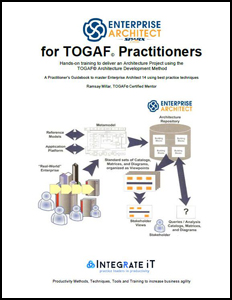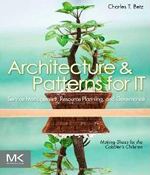
The purpose of an Enterprise Architecture capability is to identify and manage the people, process, and technology elements of an organization. All elements need to be clearly understood and available in an interactive model which can then be used to evaluate existing operations and manage change over time.
The advantages that result from a good enterprise architecture bring important business benefits, which are clearly visible in the net profit or loss of a company or organization.
What does successful Enterprise Architecture that creates business value look like?
Here are a few of the people I have discovered who are doing it right today!
Alec Blair – Enterprise Architect Manager and Coach, Alberta Health Services. Alec is an inspiration in our industry and is a fine example of the architect of the future.
www.enterprisearchitecture.ca/alberta-health-services-alec-blair-nov-20-2013-meeting/Oh
Andew Guitarte, Business Architect – A day in the life of a Business Architect
www.bainstitute.org/resources/articles/day-life-business-architect#comment-1016
Birol Berkem – From the BMM and TOGAF 9.1 toward SOA – https://www.goobiz.com/From_BMM_to_SOA.htm
Charles T.Betz said "An Architect, in the subtlest application of the word, describes one able to engage and arrange all elements of an environment to create a harmonious whole".
Charles served 6 years at Wells Fargo as VP and Enterprise Architect for IT Portfolio Management and Systems Management. He has held analyst, architect and application manager positions for AT&T, Best Buy, Target, EMA, and Accenture, specializing in IT management, Cloud, and enterprise architecture.
Charles Betz is author of The Architecture of IT Management, a comprehensive reference architecture for the “business of IT,” and co-author of several works with Lean collaborators and for ISACA’s COBIT.
Phil Cutforth MBE – All-of-Government Enterprise Architect at Department of Internal Affairs (New Zealand) shares their noteworthy success.
The New Zealand government requires services to be radically transformed for the benefit of all New Zealanders – and ICT is a key tool that will make this possible. ICT.govt.nz is the official site for the New Zealand Government ICT Functional Leader, the Government Chief Information Officer. www.ict.govt.nz/. The site includes the NZ Government Enterprise Architecture (GEA-NZ) reference architecture models that draw from a mix of well-established frameworks, notably FEAF v2, TOGAF and Archimate. The government reference models and patterns are provided under the Creative Commons License scheme (https://creativecommons.org/choose/) to both Public and Private sectors internationally. These resources are managed through the SPARX EA tool, which is recognized as the de-facto standard EA modelling tool for New Zealand Government agencies.
Serge Thorn – Business Services http://sergethorn.blogspot.fr/2014/08/business-services-what-are-they-really.html
Vincenzo Marchese – I worked as Head of Architecture Capability for a major oil company, and we used TOGAF to establish and (over 4 years mature) an architecting capability. TOGAF was minimally tailored to meet the organization’s business needs and to make it “integratable” with other IT processes. Training our 200+ architects was only the first "easy" part of truly adopting TOGAF to deliver value to the firm.
Some snippets of how this was done here: www.architecturalthinking.net
NOTEWORTH FAILURES IN ENTERPRISE ARCHITECTURE
Red Team – A slide show from McKinsey & Co.’s outside review of HealthCare.gov, in the spring of 2013 nearly six months before the ACA Federal Exchange rollout. – House Energy and Commerce Committee – https://www.npr.org/sections/alltechconsidered/2013/11/19/246132770/this-slide-shows-why-healthcare-gov-wouldnt-work-at-launch?sc=tw



